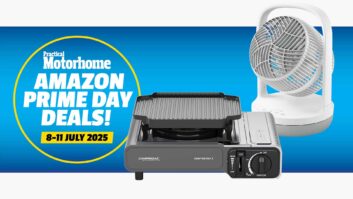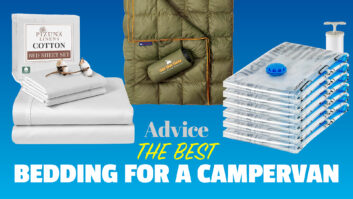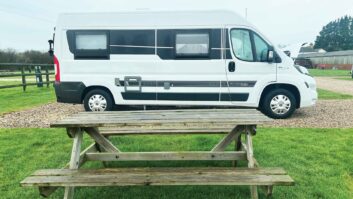Whether you’ve recently upgraded your ‘van or are new to the world of motorhoming and have just purchased your first vehicle, kitting out a motorhome with the items you’re likely to need and use will be an important step to achieving an enjoyable touring experience.
After all, the items you choose to take with you will undoubtedly make a huge difference when you’re pitched up, whether you’re staying at one of the best motorhome sites in the UK or have chosen to go off-grid.
If you’re upgrading your old ‘van to a new motorhome, you’re likely to already have the majority of the items you’d need for an enjoyable tour. If your new model is bigger, you’re probably going to have a lot more space, so fitting everything in will not be a problem. However, if you’ve swapped to a smaller ‘van, choosing carefully and following some simple tips will ensure you fit all of the essentials in when you’re loading a motorhome.
In comparison, if this is your first ‘van, you’ll need to give it some thought to get your essentials together so they’re ready for loading.
The majority of ‘van owners will keep the basics in their motorhome on a permanent basis, only adding everyday items like clothing and perishable goods when it’s time to go away.
When I’m kitting out a motorhome for the first time, I initially check to see which of my plastic storage boxes will best utilise the available cupboard space. These can then be allocated roles based on their dimensions and where they are situated.
Combine these with tour-enhancing accessories such as the best motorhome awning and you’ll be all set for a memorable campsite experience.
Bedding to take on tour
Having the best bedding for a campervan can make a big difference to your sleeping experience on tour.
Whether you opt for a sleeping bag, a duvet or a domestic-style bed-making kit will largely be influenced by your personal preferences and the room you have in your ‘van. No matter which you choose, it should be fairly simple to store, as bedding is adaptable in shape, so a storage box isn’t going to be required.
A space-saving tip I’m particularly fond of is storing a couple of pillows in large or bespoke cushion covers. This means they can be used both day and night, but don’t take up cupboard space. Additional bedding can be kept in the overcab or the underbed lockers.
Kitting out the kitchen
If you want to have access to a cup of tea once you’ve pitched up, one of the best motorhome kettles will be a very important accessory to pack.
I’d advise choosing pans and a kettle that fit inside one another if possible (perhaps with a tea towel between each), as this will offer a useful space-saving technique. A large plastic storage box helps to keep things tidy here.
When it comes to buying the best motorhome crockery, the virtually indestructible melamine is an ever popular choice. However, I personally prefer thin white glass crockery, such as Corelle, or Oftast, the Ikea equivalent.
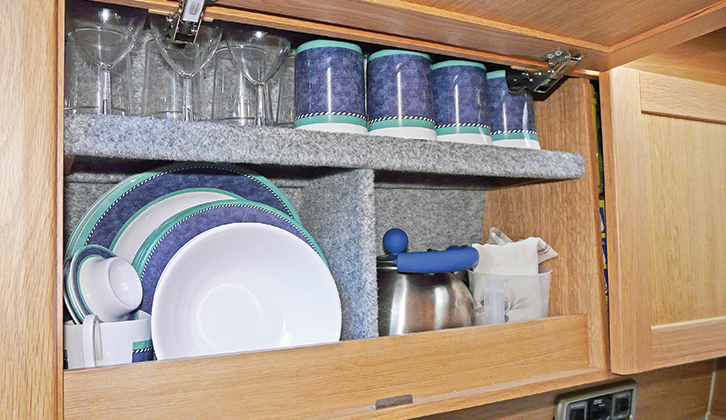
They might be relatively heavy, but I’ve found plates will stack away compactly, providing a hygienic and stain-resistant method for eating on tour. I’d suggest fitting out a bespoke crockery cupboard – this will minimise the space you need and also help to keep rattling and chipping to a minimum.
Cutlery will most likely be fine in a cutlery tray in a drawer, but you can avoid rattling by using or making a tool roll to store it in.
A small kettle and toaster can be fitted into any spaces left in the kitchen, as can a small water-carrier for drinking water supplies, if, like us, you prefer to keep the tank water for washing.
When it comes to oil, vinegar and washing-up liquids, I’d suggest fitting these into a small plastic container to keep them upright and lower the chances of any leaking. You could also store 3-in-One oil, WD-40 and a small bottle of methylated spirits here, with the latter useful as a solvent for ink stains and sticky adhesive remains.
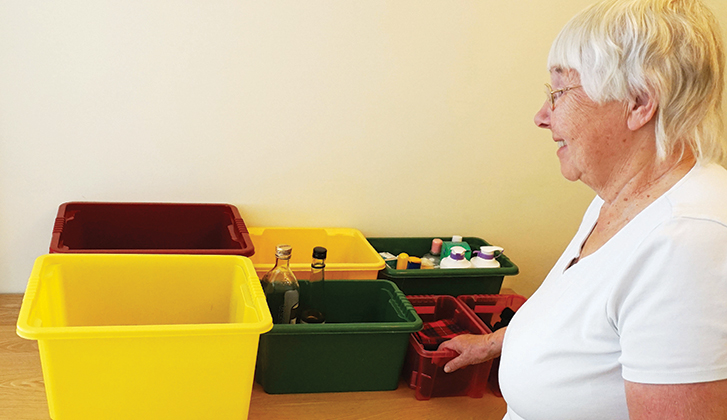
Food
Don’t store any perishable goods in the fridge until the last minute. I generally put meat in the freezer compartment just when travelling, as it’s an area that is otherwise fairly underutilised.
Due to their weight, you’ll need to store your tinned goods low down. I’m a fan of fitting them in a suitable plastic box, so I can then reach into them as you would a drawer.
Toolkit to take on tour
The items you choose to pack in your motorhome tool kit very much come down to your DIY ability and the storage space you have to hand.
I’d recommend having a small multimeter, a set of screwdrivers, a small hacksaw, spanners and pliers packed. Other useful items include cable ties in a number of sizes, connector blocks and fuses. It’s also worth having some miscellaneous screws, washers, and nuts and bolts stored in a small container, along with a reel of insulating tape.
Having a couple of old wire coat hangers will be useful for performing a variety of emergency tasks that could occur, while I also make sure I always have duct tape and some extra-strong plastic rubble sacks when I’m away – after all, you never know when a window may break or a roof light may be lost and you’ll need to carry out some temporary repairs.
Pitching up
Items needed for pitching can include levelling ramps (our best motorhome levelling ramps guide will help you find the pair for you), electrical cables and connectors, an aerial cable, water-hoses and water-carriers. Those who have a smaller ‘van may find these bulky to fit in but use the room under the floor at the rear of the motorhome if storage is provided.
I also take a full-length mains cable on a reel and a half-length one folded, something which I’ve found I can generally fit into a door pocket – convenient.
It’s worth giving some thought to where you will store your folding camping chairs and table – you’ll want to ensure you have easy access while also keeping them out of the way when you don’t need them. One possibility if there’s space is to fasten them with straps behind the rear seat backrests.
Medical equipment
Don’t get your medical kit muddled up with your first-aid kit. Find a suitable small box where you can store tablets and medicine for digestive upsets, headaches and pains, travel sickness, hayfever and so on, as well as more routine medication.
Other sensible additions to pack include sticking plasters, elastic bandages, nail-clippers, tweezers and small scissors.

Leisure accessories
Cameras, laptops and binoculars will need to be stored somewhere safely, while accessories such as books can be fitted in remaining spaces, door pockets or underseat compartments. I’d recommend taking paper, envelopes and stamps too – you never know when they might come in handy. Simply store them in a thin packet. Don’t forget to take something like a small sewing kit away too incase any emergency repairs are required.
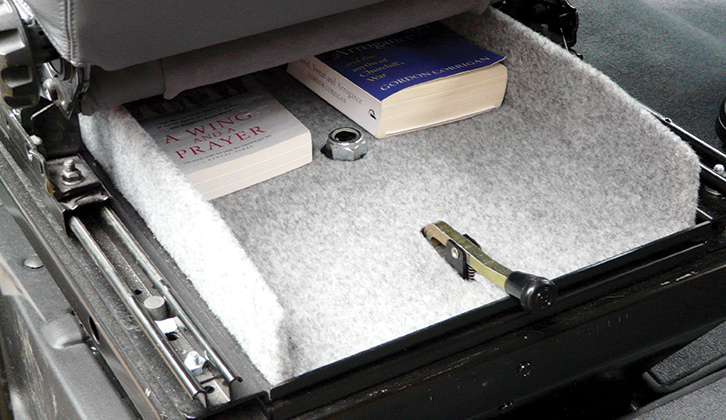
Are you thinking of watching some television when you’re on tour but aren’t sure what type of device to use? We’re here to help as we answer ‘Can you use a normal TV in a motorhome?‘.
Driving accessories to take
If you’re planning to take your motorhome to Europe, you must have high-vis jackets – store these somewhere where they can easily be accessed before you leave the vehicle. Don’t forget to stow your warning triangles and first-aid kit in a similarly accessible spot.
No doubt there will be plenty of smaller items to accommodate, such as maps and guides, spare glasses and sunglasses. Most of these can be stored in the door pockets, except perhaps large map-books, which can be stored flat, possibly on the floor of the Luton roof or similar.
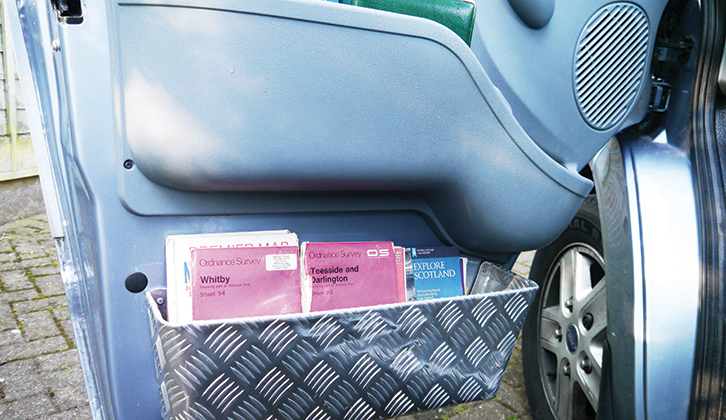
Many ’vans have full-sized spare wheels under the rear, but if not, rather than depending on a ‘gunge kit’, you might consider adding a spare wheel, or at least the tyre, so you are not stranded with an irreparable wheel on the Continent on a bank holiday! These can be stored in a bedding locker or the garage, or attached to the rear doors – but check your payload.
After kitting out your motorhome, it will be time to choose your touring destination – if you’re after some inspiration, our guide to the best UK road trips is full of ideas and inspiration.
Future Publishing Limited, the publisher of Practical Motorhome, provides the information in this article in good faith and makes no representation as to its completeness or accuracy. Individuals carrying out the instructions do so at their own risk and must exercise their independent judgement in determining the appropriateness of the advice to their circumstances and skill level. References to specific products are for illustration only and not intended as recommendation. To the fullest extent permitted by law, neither Future nor its employees or agents shall have any liability in connection with the use of this information. Double check any warranty is not affected before proceeding.
If you’ve enjoyed reading this article, why not get the latest news, reviews and features delivered direct to your door or inbox every month. Take advantage of our brilliant Practical Motorhome magazine SUBSCRIBERS’ OFFER and SIGN UP TO OUR NEWSLETTER for regular weekly updates on all things motorhome related.



